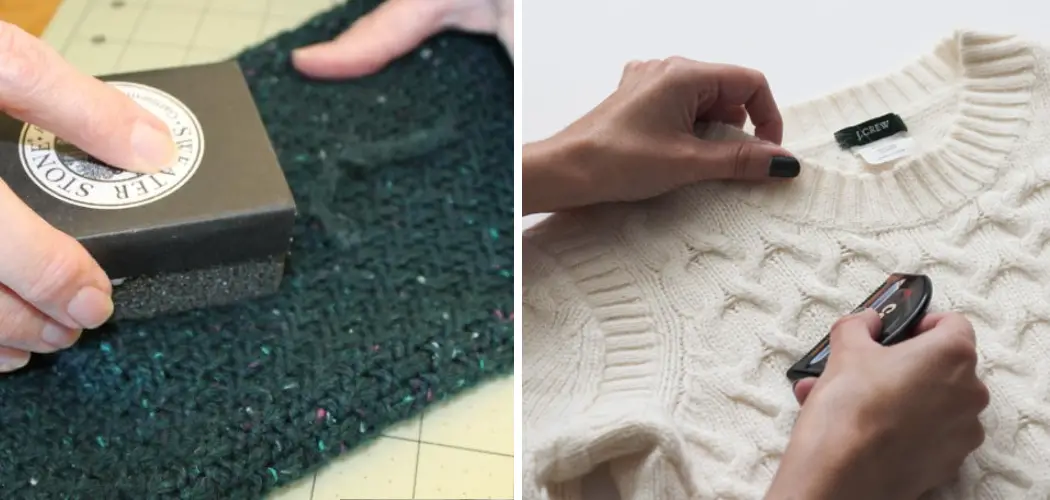A sweater stone is an eco-friendly and effective tool for maintaining and refreshing your knitwear. Made from natural pumice, it gently removes pilling and fuzz without damaging the fabric.

In this guide on how to use sweater stone, we’ll walk you through the simple steps to use a sweater stone, helping your sweaters, cardigans, and woolen accessories look their best for years to come. But before we begin, let’s learn a little more about sweater stones and why they are a must-have for any wardrobe.
What is a Sweater Stone?
A sweater stone is a pumice-like tool used to remove pills and fuzz from knitwear. It is typically made from natural pumice or volcanic rock, ensuring that its use is both safe for the environment and gentle on your clothes. The texture of the stone is abrasive enough to remove pills and fuzz, but not so harsh that it damages the fabric.
It is a reusable tool that requires no batteries or electricity, making it a cost-effective and sustainable option for maintaining your knitwear. You can find sweater stones in most home care or laundry aisles of your local grocery or department store. The size and shape of the sweater stone can vary, but they are usually small enough to hold comfortably in your hand.
Why Use a Sweater Stone?

Pilling and fuzz are natural occurrences in most knitwear, caused by friction from wear and washing. These tiny balls of fuzz not only make your clothes look old and worn out but can also be uncomfortable against your skin. Traditional methods of removing pilling, such as using razors or scissors, can be risky and may damage the fabric.
Sweater stones offer a safer and more efficient solution by gently lifting the pills and fuzz away without compromising the quality of the fabric. Using a sweater stone can also extend the life of your knitwear, saving you money in the long run.
Needed Materials
Before you begin using your sweater stone, there are a few materials you’ll need to gather:
Your Knitwear:
The first and most important item you’ll need is the knitwear you want to refresh. This can include sweaters, cardigans, scarves, mittens, or any other woolen items that have pilling or fuzz.
A Sweater Stone:
As mentioned above, a sweater stone is essential for this process. You can purchase one from a store or online, or you can make your own using a pumice stone.
A Clean Surface:
You’ll want to work on a clean and flat surface, such as a table or countertop, so that the pills and fuzz can fall away easily without creating more mess.
A Lint Roller (Optional):
If you’re dealing with particularly stubborn pills or fuzz, a lint roller can help pick them up after using the sweater stone.
11 Step-by-step Guidelines on How to Use Sweater Stone
Step 1: Understanding Sweater Stones
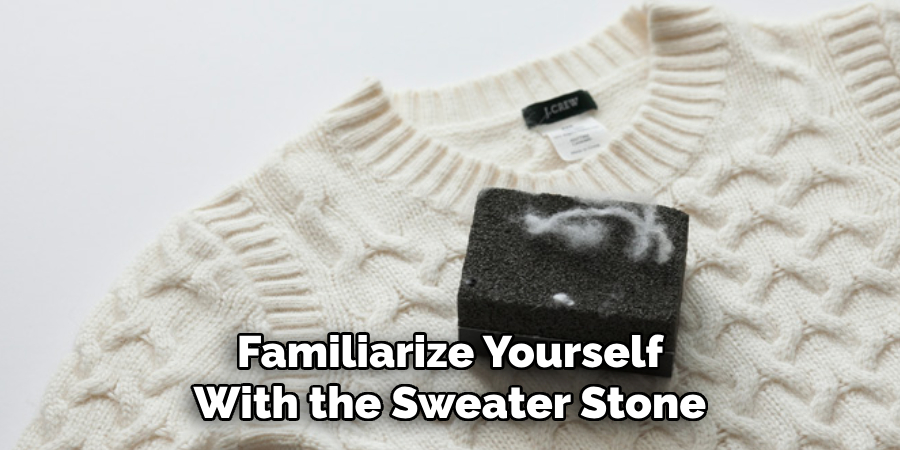
Before you begin, it’s essential to familiarize yourself with the sweater stone and how it works. The abrasive texture of the stone will gently remove pills and fuzz from your knitwear without damaging the fabric. But it’s still a good idea to test it on an inconspicuous area of your garment first, just in case. You can also practice using the sweater stone on an old or inexpensive item of clothing to get a feel for it.
Step 2: Clean the Surface
Make sure your work surface is clean and free from any debris that could potentially stick to your garment during the process. The cleaner the surface, the easier it will be to remove any pills and fuzz that fall away. You can also lay down a towel or sheet to catch any falling debris.
It’s also a good idea to wash your hands before handling the garment to avoid any dirt or oils transferring onto it. But if your hands are clean and dry, you should be fine. It’s time to start using your sweater stone.
Step 3: Lay Out Your Knitwear
Lay your knitwear flat on a clean surface with the area you want to refresh facing up. If you’re working on a sweater, make sure it is inside out so that you can easily see and reach the pills and fuzz.
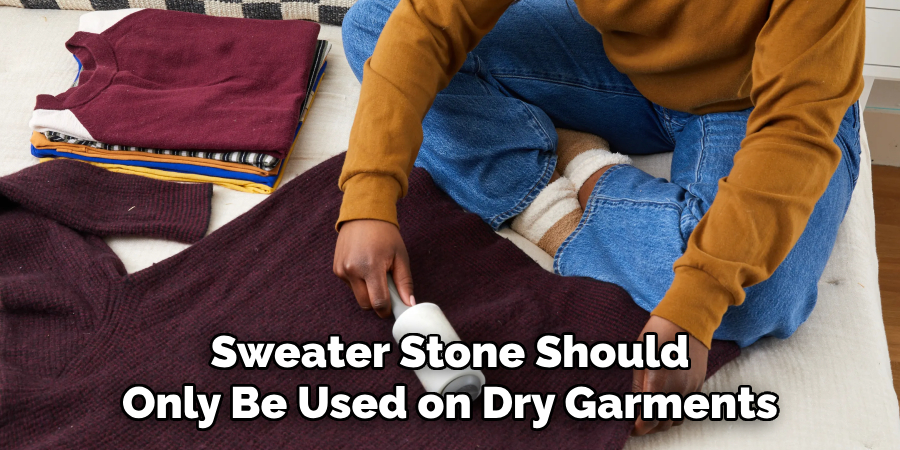
The sweater stone should only be used on dry garments, so make sure your item is completely dry before starting. You can also lightly steam your garment before starting to help loosen any pills or fuzz. It’s best to work on one small section at a time, so you have better control and can achieve more precise results.
Step 4: Begin Using the Sweater Stone
Hold the sweater stone firmly, but not too tightly, in your dominant hand. With your other hand, stretch the fabric over the area you want to refresh so that it’s taut. Use small circular motions to gently rub the sweater stone over the surface of the garment.
Breathe and take your time, focusing on one small area at a time. Do not apply too much pressure, as this could damage the fabric. The pills and fuzz should start to come off easily, but if they don’t, you can try using a lint roller to pick them up.
Step 5: Check Your Progress
As you use the sweater stone, stop periodically to check your progress. You should start to see pills and fuzz coming off the garment onto the stone or falling away onto the surface below. If you’re working on a particularly stubborn area, you may need to go over it a few times to remove all the pills and fuzz completely.
The goal is to remove as much as possible without causing any damage to the fabric. You can also use a lint roller to pick up any remaining pills or fuzz. It’s important to note that not all pills and fuzz may come off in one go, especially if they are deeply embedded.
Step 6: Empty Your Sweater Stone

As your sweater stone collects pills and fuzz, it will become less effective. So make sure to empty it periodically by rubbing it against a dry towel or brushing off any debris. This will allow the stone to continue working its magic on your garment. It’s also a good idea to rinse the stone with water and let it air dry before using it again.
You can also use mild soap to clean the stone if needed. But make sure it is completely dry before continuing to use it. But if you’re using a pumice stone, it’s disposable, so you can simply discard it when it becomes too clogged with pills and fuzz.
Step 7: Continue Refreshing Your Garment
Move around your garment, refreshing one small area at a time until you’ve covered the entire surface. You can also use the sweater stone on any cuffs, collars, or other areas where pills and fuzz may be present.
Take breaks as needed and check your progress frequently to ensure you’re not causing any damage or missing any spots. But remember, it’s better to go over an area a few times than to apply too much pressure and damage the fabric. You can also use a lint roller to pick up any remaining pills and fuzz.
Step 8: Use a Lint Roller (Optional)
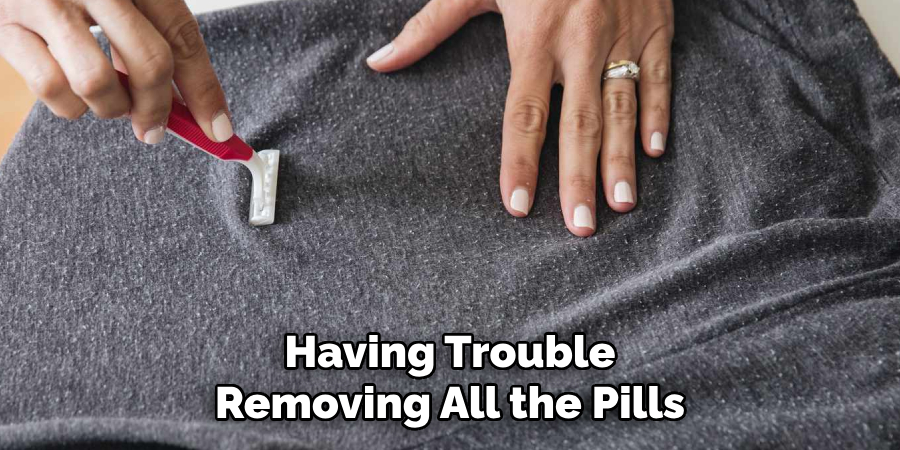
If you’re having trouble removing all the pills and fuzz with the sweater stone alone, you can use a lint roller to pick up any remaining debris. Simply roll the lint roller over the garment, and it will pick up any pills or fuzz that may still be present. Although it’s optional, this step can help achieve a smoother finish.
You can also use a lint roller to remove any pills or fuzz that may have fallen onto the surface below. But make sure to empty and rinse the lint roller as needed. Therefore, it’s a good idea to have one on hand while using the sweater stone.
Step 9: Inspect Your Garment
Once you’ve gone over your entire garment with the sweater stone, take a closer look to make sure all the pills and fuzz have been removed. If you notice any missed spots, go over them again with the sweater stone or use a lint roller to pick up any remaining debris. If you’re satisfied with the results, move on to the next step. The final step is to take care of your garment.
It’s important to store your knitwear properly, so it stays in good condition and doesn’t develop more pills or fuzz. The final step is to take care of your garment. It’s important to store your knitwear properly, so it stays in good condition and doesn’t develop more pills or fuzz.
Step 10: Turn Your Garment Right Side Out
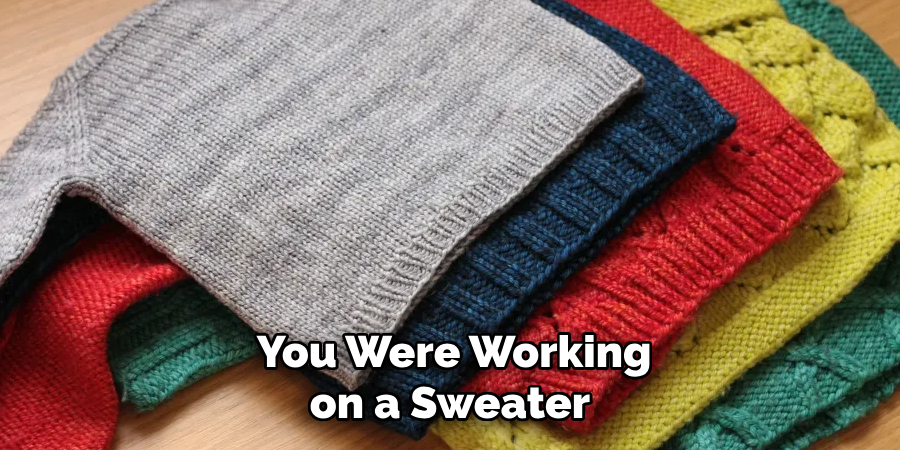
If you were working on a sweater or any other garment that needed to be turned inside out, carefully turn it back right side out. Gently shake the garment to remove any pills or fuzz that may have accumulated.
You can also use a lint roller to pick up any remaining debris. But be careful not to apply too much pressure or tug on the fabric, as this could cause more pills and fuzz to form. It’s also a good idea to give your garment a gentle steaming to refresh the fabric. But make sure it’s completely dry before storing.
Step 11: Proper Care for Your Refreshed Knitwear
Finally, on how to use sweater stone, it’s important to properly care for your refreshed knitwear to avoid future pilling and fuzz. One way to do this is by washing your garments inside out on a gentle cycle or handwashing them. Avoid using fabric softener, as it can contribute to pilling and fuzz formation.
Lay your knitwear flat to dry instead of hanging it, as this can stretch out the fabric and cause more pills. Always store your knitwear folded or rolled, rather than hanging, to maintain its shape. By following these tips and using the sweater stone regularly, you can keep your knitwear looking fresh and free of pills and fuzz for many wears to come.
Proper care will help your refreshed garments last longer and stay looking like new. Congratulations, you now know how to use a sweater stone to refresh your knitwear and keep it looking great! So, don’t let pilling and fuzz stop you from wearing your favorite knitwear. Just follow these simple steps and enjoy your refreshed garments for many more wears to come.
Cleaning and Maintaining the Sweater Stone
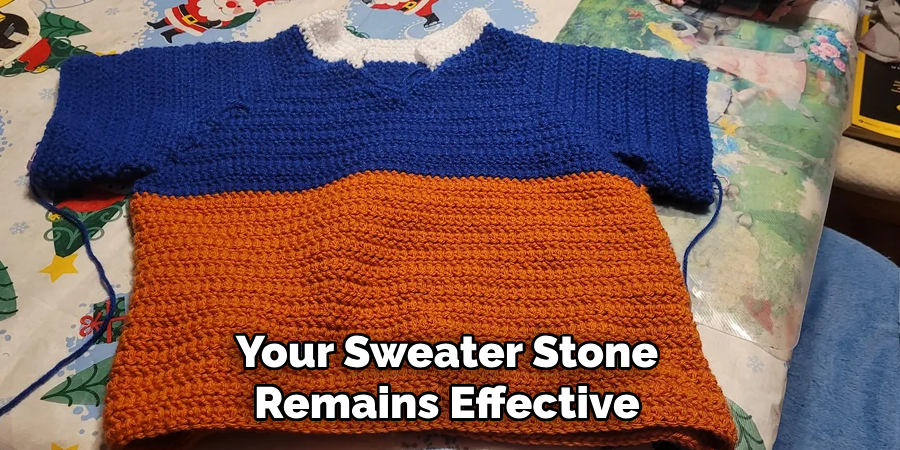
To ensure that your sweater stone remains effective, it’s important to clean and maintain it properly. After each use, make sure to remove any debris by rubbing the stone against a dry towel or brushing it off. You can also rinse the stone with water if needed, but make sure it is completely dry before using it again.
If you notice any buildup on your sweater stone, you can use a mild soap to clean it. Simply lather the stone with soap and water, then rinse thoroughly and let it air dry completely before using it again. Avoid using harsh chemicals or abrasive materials on the stone, as this could damage its effectiveness.
Troubleshooting Common Issues
- If You’re Having Trouble Removing Pills and Fuzz, Try Using a Lint Roller or Washing Your Garment Inside Out Before Using the Sweater Stone.
- If Your Sweater Stone Becomes Less Effective Over Time, It May Be Time to Replace It. Sweater Stones Typically Last for Multiple Uses but Will Eventually Wear Down and Lose Their Effectiveness.
- Avoid Using the Sweater Stone on Delicate Fabrics, Such as Cashmere or Silk, as It Could Damage the Fabric. Instead, Use a Lint Roller to Remove Pills and Fuzz from These Types of Fabrics.
- If You Notice Any Damage or Snags on Your Garment After Using the Sweater Stone, Stop Using It Immediately and Try a Different Method to Remove Pills and Fuzz.
- Always Use Caution When Using the Sweater Stone, as Too Much Pressure or Aggressive Movements Could Damage the Fabric. If You’re Unsure, Start with a Lighter Touch and Increase Pressure As Needed.
By following these tips on how to use sweater stone and properly maintaining your sweater stone, you can keep your knitwear looking fresh and new for many years to come.
Frequently Asked Questions
Q: Will Using a Sweater Stone Damage My Garments?
A: When used properly, a sweater stone should not cause any damage to your garments. However, it’s important to avoid applying too much pressure and to always check your progress to ensure you’re not causing any damage.
Q: How Often Should I Use a Sweater Stone?
A: It’s recommended to only use a sweater stone when needed, as excessive use can cause damage to the fabric. However, if you notice pilling or fuzz forming on your garments, you can use the sweater stone again. Just make sure to follow the proper steps and not overuse it.
Q: Can I Use a Sweater Stone on Other Types of Fabric?

A: While a sweater stone is specifically designed for knitwear, it can also be used on other types of fabric such as fleece or upholstery. Just make sure to test it on a small, inconspicuous area first to ensure it won’t damage the fabric. However, it’s not recommended to use a sweater stone on delicate fabrics such as silk or cashmere.
Q: How Do I Store My Sweater Stone?
A: It’s best to store your sweater stone in a cool, dry place when not in use. Make sure it is completely dry before storing it to prevent mold or mildew from forming. You can also keep it in a small bag or container to protect it from dust and debris.
Q: Can I Use a Sweater Stone on Clothing with Embellishments?
A: It’s not recommended to use a sweater stone on clothing with embellishments such as beads, sequins, or embroidery. These decorations can easily get caught on the stone and cause damage to both the garment and the stone. If your garment has these types of embellishments, it’s best to use a different method for removing pills and fuzz.
Conclusion
Revitalizing your beloved knitwear with a sweater stone is not only a practical skill but also a mindful practice that extends the life of your garments. With patience and gentle technique, you can successfully remove unwanted pills and fuzz, restoring your items to their former glory.
Remember, the key to maintaining the pristine condition of knitwear lies in proper care post-refreshing: wash gently, dry flat, and store correctly.
By following these steps on how to use sweater stone, you can ensure your sweaters and other knits remain cozy, comfortable, and chic wear after wear. Cheers to sustainable fashion practices and to giving your favorite pieces a new lease on life! So, go grab a sweater stone and get ready to refresh your knitwear collection.

